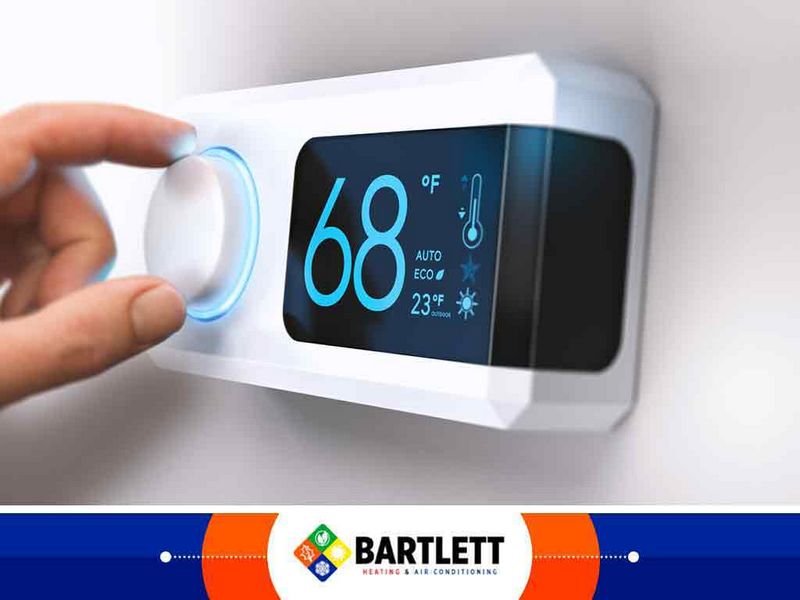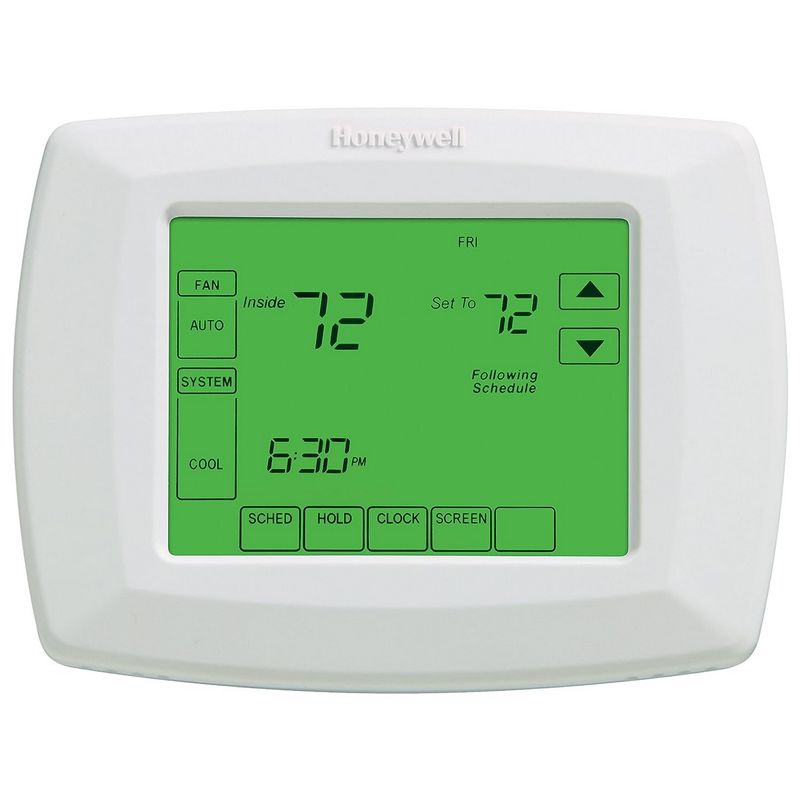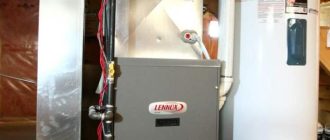
Understanding Programmable Thermostats: Are They a Necessity?
Wouldn’t it be great if your thermostat could adapt to your lifestyle and save you money at the same time? A programmable thermostat does just that. It’s a device that allows you to set the temperature of your home in advance, according to a set schedule. This means you can have different temperatures for different times of the day, making it more comfortable and energy-efficient at the same time.
Programmable thermostats come in various models and offer a wide range of features. Some can be controlled remotely through a smartphone app, while others learn your habits and adjust the temperature accordingly. They often have settings for weekdays and weekends, and some even have vacation modes. With a programmable thermostat, you can have the perfect temperature when you wake up, arrive home, or go to bed without having to manually adjust it each time.
But do you really need a programmable thermostat? The answer depends on your lifestyle and preferences. If you have a consistent daily routine, a programmable thermostat can help you save money by automatically adjusting the temperature when you’re away from home. It can also provide you with a more comfortable living environment by ensuring that your home is always at the desired temperature. In addition, programmable thermostats can help reduce your carbon footprint by optimizing your energy usage.
On the other hand, if you have an erratic schedule or frequently change your plans, a programmable thermostat may not be as beneficial for you. In such cases, a smart thermostat that can be controlled remotely through your phone may be a better option. Ultimately, the decision to get a programmable thermostat depends on your individual needs and lifestyle. However, it’s worth noting that programmable thermostats have been proven to save energy and reduce heating and cooling costs, making them a wise investment for many homeowners.
What is a Programmable Thermostat?
A programmable thermostat is a device that allows you to set a schedule for your heating and cooling system to automatically adjust the temperature in your home based on your preferences. It is an advanced version of a traditional thermostat that offers more control and flexibility.
With a programmable thermostat, you can program different temperature settings for different times of the day or week. For example, you can set it to lower the temperature during the hours when you’re usually away from home to save energy and money on your utility bills. It can also automatically adjust the temperature based on the time of day or the weather conditions outside.
Programmable thermostats come in different types and models, but most of them offer features such as:
- Temperature scheduling: You can set different temperature settings for different times of the day or week. This allows you to maintain a comfortable temperature when you’re at home and save energy when you’re away.
- Temperature override: You can manually override the programmed schedule temporarily if you want to adjust the temperature outside of the scheduled settings.
- Energy usage monitoring: Some programmable thermostats provide information on your energy usage, allowing you to track and manage your energy consumption.
- Smart home integration: Many programmable thermostats are compatible with smart home systems, allowing you to control them remotely via a smartphone app or integrate them with other smart devices in your home.
Overall, a programmable thermostat offers convenience, energy savings, and increased control over your home’s temperature. It can help you create a comfortable living environment while reducing your energy consumption and lowering your utility bills.
How Does a Programmable Thermostat Work?
A programmable thermostat is a device that allows you to set different temperature settings for different times of the day. It works by controlling your heating and cooling system to maintain the desired temperature at different times throughout the day or week.
Here is a step-by-step guide on how a programmable thermostat works:
- Installation: You first need to install the programmable thermostat on your wall. Follow the manufacturer’s instructions for proper installation.
- Programming: Once installed, you can program the thermostat to adjust the temperature settings based on your preferences. Most programmable thermostats have a user-friendly interface that allows you to easily set up different temperature schedules.
- Schedule: You can set different temperature settings for different times of the day or week. For example, you can set a lower temperature during the night when you are asleep, and a higher temperature during the day when you are awake.
- Modes: Programmable thermostats have different modes, such as “heat,” “cool,” and “auto.” In the “heat” mode, the thermostat will only activate the heating system when the temperature falls below the set temperature. In the “cool” mode, it will only activate the cooling system when the temperature rises above the set temperature. The “auto” mode switches between heating and cooling as necessary to maintain the desired temperature.
- Override: If you need to temporarily adjust the temperature outside of the programmed schedule, you can use the override function. This allows you to manually set the temperature for a specific period of time.
- Energy Savings: One of the main benefits of a programmable thermostat is its ability to save energy and reduce utility bills. By automatically adjusting the temperature when you are not at home or asleep, you can avoid wasting energy on unnecessary heating or cooling.
- Compatibility: It’s important to ensure that your heating and cooling system is compatible with a programmable thermostat. Some systems may require additional wiring or modifications to work properly.
Overall, a programmable thermostat offers convenience, energy savings, and improved comfort. With the ability to set customized temperature schedules, you can enjoy a comfortable indoor environment while saving money on your heating and cooling costs.
Advantages of a Programmable Thermostat
- Energy savings: One of the biggest advantages of a programmable thermostat is the potential for energy savings. By programming your thermostat to automatically adjust the temperature based on when you’re home or away, you can significantly reduce your energy consumption and lower your utility bills.
- Comfort: With a programmable thermostat, you can ensure that your home is always at the ideal temperature when you need it. You can program different temperature settings for different times of the day, allowing you to wake up to a warm house in the morning and come home to a cool house in the evening.
- Convenience: Programmable thermostats offer the convenience of automatically adjusting the temperature in your home without requiring manual intervention. Once you’ve programmed your thermostat, you can set it and forget it, allowing you to focus on other tasks and activities.
- Accuracy: Programmable thermostats generally have more accurate temperature control than traditional thermostats. They use advanced technology to regulate the temperature in your home, ensuring that it stays within a narrow range of your desired setting.
- Remote access: Many programmable thermostats offer remote access through smartphone apps. This allows you to adjust the temperature and monitor your energy usage even when you’re not at home. With remote access, you have full control over your thermostat no matter where you are.
- Customization: Programmable thermostats offer a high level of customization. You can set different temperature schedules for weekdays and weekends, create vacation settings, and even set different temperatures for different rooms in your home. This level of customization allows you to tailor your heating and cooling preferences to your specific needs and preferences.
Why Should You Invest in a Programmable Thermostat?
A programmable thermostat, also known as a smart thermostat, is an advanced device that allows you to control the temperature of your home according to a pre-set schedule. Instead of manually adjusting your thermostat throughout the day, a programmable thermostat automates this process, providing convenience and efficiency.
1. Energy Efficiency:
Investing in a programmable thermostat can lead to significant energy savings. By automatically adjusting the temperature based on when you are home or away, the thermostat can prevent unnecessary heating or cooling. This results in reduced energy consumption and lower utility bills.
2. Cost Savings:
The energy savings achieved with a programmable thermostat can translate into cost savings over time. By using less energy to heat or cool your home, you can expect to see a noticeable decrease in your monthly energy bills. This makes a programmable thermostat a wise long-term investment.
3. Comfort and Convenience:
With a programmable thermostat, you can easily create a customized schedule that aligns with your daily routine. For example, you can set the temperature to be cooler during the night and warmer in the morning, ensuring optimal comfort at all times. Additionally, some programmable thermostats can be controlled remotely through a smartphone app, allowing you to adjust the temperature from anywhere.
4. Environmentally Friendly:
Reducing energy consumption not only saves you money but also helps protect the environment. By using a programmable thermostat, you can contribute to the overall goal of reducing greenhouse gas emissions and conserving energy resources, promoting a more sustainable future.
5. Smart Features:
Many programmable thermostats come with additional smart features that enhance their functionality. These features may include learning capabilities, which allow the thermostat to adapt to your preferences over time, or integration with other smart home systems, such as voice control or compatibility with virtual assistants like Amazon Alexa or Google Assistant.
|
In conclusion, investing in a programmable thermostat offers several benefits, including energy efficiency, cost savings, comfort and convenience, environmental friendliness, and access to smart features. With these advantages, a programmable thermostat can improve your home’s overall energy management and provide you with greater control over your indoor climate.
Savings on Energy Bills
One of the main benefits of using a programmable thermostat is the savings it can provide on energy bills. By allowing you to set different temperature levels for different times of the day, you can optimize energy usage and reduce wasted energy when you’re not at home or when you’re sleeping.
Energy-efficient temperature settings: With a programmable thermostat, you can easily set lower temperatures during times when you’re away from home or during the night when you’re sleeping. For example, you can program the thermostat to lower the temperature during work hours or at night to save energy. This can lead to significant savings on your heating and cooling costs.
Prevents unnecessary energy usage: Forgetting to adjust the thermostat before leaving the house can result in unnecessary energy usage and higher bills. With a programmable thermostat, you can set it to adjust automatically, so you don’t have to rely on your memory. This ensures that energy isn’t wasted when you’re not at home, which can lead to significant savings over time.
Smart features: Many programmable thermostats now come with smart features that can further enhance energy savings. These features include Wi-Fi connectivity, learning capabilities, and compatibility with smart home systems. With these smart features, the thermostat can learn your schedule and adjust the temperature accordingly, optimizing energy usage and providing even more savings on your energy bills.
Data monitoring: Some programmable thermostats also offer data monitoring features that allow you to track your energy usage and see how it’s affecting your bills. By analyzing this data, you can identify patterns and make adjustments to your settings to maximize your energy savings.
Long-term savings: While the upfront cost of a programmable thermostat may be higher than a traditional thermostat, the long-term savings can make it worth the investment. With optimized energy usage and reduced wasted energy, you can expect to see lower energy bills over time, which can offset the initial cost of the thermostat.
In conclusion, a programmable thermostat can provide significant savings on energy bills by allowing you to optimize energy usage, prevent unnecessary energy usage, and take advantage of smart features and data monitoring. With the long-term savings it can provide, investing in a programmable thermostat can be a wise choice for homeowners looking to reduce their energy costs.
Increased Comfort and Convenience
A programmable thermostat offers increased comfort and convenience for homeowners. With a programmable thermostat, you have the ability to set different temperature settings for different times of the day. This means that you can have your home at a comfortable temperature when you wake up in the morning, come home from work, or go to bed at night.
Instead of manually adjusting the thermostat multiple times a day, a programmable thermostat allows you to set a schedule and forget about it. This not only saves you time and effort but also ensures that your home is always at the desired temperature without any manual intervention.

In addition to comfort, a programmable thermostat also offers convenience. Many programmable thermostats can be controlled remotely through a smartphone app or a web portal. This means that you can adjust the temperature of your home even when you are not physically present. If you are coming home earlier than usual or staying out late, you can easily modify the temperature settings to ensure that your home is comfortable when you arrive.
Furthermore, some programmable thermostats come with advanced features such as learning algorithms that can analyze your daily routine and adjust temperature settings accordingly. This means that the thermostat can learn when you typically come and go, and automatically adjust the temperature to save energy when you are away.
A programmable thermostat also allows you to create temperature zones in your home. This is particularly useful if you have multiple floors or rooms that require different temperature settings. With a programmable thermostat, you can easily set different schedules for different zones, ensuring that each area of your home is heated or cooled to the desired temperature.
Reduced Environmental Impact
One of the most significant benefits of programmable thermostats is their ability to reduce the environmental impact of heating and cooling systems. By allowing users to schedule temperature adjustments based on their specific needs, programmable thermostats help minimize energy waste and reduce greenhouse gas emissions.
Traditional thermostats require manual adjustment each time the temperature needs to be changed, which can easily result in unnecessary energy consumption. However, programmable thermostats can be programmed to automatically adjust the temperature based on preset schedules.
This means that homeowners can set the thermostat to lower the temperature during times when they are away from home or asleep and have it automatically increase the temperature before they return or wake up. This ensures a comfortable living environment while also saving energy.
Additionally, programmable thermostats often come with features such as occupancy sensors or adaptive algorithms that learn and adjust to the user’s behavior, optimizing energy usage even further. For example, if the thermostat detects that no one is home, it can adjust the temperature accordingly to minimize energy waste.
The reduced energy consumption provided by programmable thermostats not only helps save money on utility bills but also contributes to a greener planet by reducing the overall demand for energy. By adopting programmable thermostats, homeowners can play an active role in reducing their carbon footprint and combating climate change.
Furthermore, programmable thermostats can be integrated with other smart home devices and technologies to create a comprehensive energy management system. For example, they can be connected to home automation systems or voice-activated assistants, allowing users to control the thermostat remotely or through voice commands.
In conclusion, the use of programmable thermostats can significantly reduce the environmental impact of heating and cooling systems. By minimizing energy waste and optimizing temperature adjustments, these devices help to conserve energy, lower greenhouse gas emissions, and create a more sustainable living environment.
Compatibility with Smart Home Systems
Programmable thermostats have become an important part of smart home systems. These thermostats can be integrated with other smart devices, such as smart speakers, security systems, and lighting systems, to create a fully automated and connected home.
When choosing a programmable thermostat, it is important to consider its compatibility with your existing smart home system. Some thermostats are designed to work seamlessly with popular smart home platforms like Amazon Alexa, Google Assistant, or Apple HomeKit. This means that you can control your thermostat using voice commands or through a mobile app that is linked to your smart home system.
Having a programmable thermostat that is compatible with your smart home system enables you to create customized heating and cooling schedules based on your daily routines. For example, you can set the thermostat to automatically lower the temperature when you leave the house and raise it back up before you return. This not only helps to save energy and reduce utility bills but also provides a convenient and comfortable environment when you are at home.
In addition to integration with smart home systems, some programmable thermostats also offer additional features like geofencing. Geofencing uses your smartphone’s location to detect when you are nearing home and adjusts the temperature accordingly. This ensures that your home is always at the desired temperature when you arrive.
It is important to note that not all smart home systems are compatible with every programmable thermostat. Before purchasing a thermostat, it is recommended to check its compatibility with your specific smart home system. Most manufacturers provide a list of compatible systems on their websites or product packaging.
Factors to Consider Before Buying a Programmable Thermostat
When considering purchasing a programmable thermostat, there are several key factors to take into account. These factors will help you determine which thermostat is the right fit for your home and lifestyle. Here are some important considerations:
- Compatibility: Before buying a programmable thermostat, it’s essential to check if it is compatible with your heating and cooling system. Look for compatibility information provided by the manufacturer to ensure that the thermostat will work effectively with your existing HVAC system.
- Programming Options: Programmable thermostats offer various programming options, so it’s important to choose one that suits your needs. Some thermostats allow for daily programming, while others offer weekly or even monthly programming. Consider your schedule and how often you would like to adjust the temperature settings.
- User-Friendly Interface: Look for a thermostat that has a user-friendly interface, with easy-to-read and navigate controls. A clear display and intuitive menu can make it much simpler to program and adjust temperature settings.
- Energy Efficiency: One of the main benefits of a programmable thermostat is energy savings. Check for features like smart sensors, adaptive learning, and energy usage reports that can help optimize your heating and cooling efficiency, ultimately reducing your energy bills.
- Wireless Connectivity: Some programmable thermostats offer wireless connectivity, allowing you to control and monitor your home’s temperature remotely. This feature can be especially convenient if you are away from home often or want to adjust the temperature while lying in bed or sitting on the couch.
- Compatibility with Smart Home Systems: If you have a smart home system, consider purchasing a programmable thermostat that is compatible with your existing setup. This compatibility will enable you to integrate your thermostat with other smart devices and control them through a single platform.
- Budget: Programmable thermostats come in a range of prices. Determine your budget and find a thermostat that meets your requirements without breaking the bank. Keep in mind that higher-priced thermostats often offer more advanced features and greater energy savings.
By considering these factors before buying a programmable thermostat, you can ensure that you choose the right one for your home and maximize its benefits in terms of comfort, convenience, and energy savings.
Type of Heating and Cooling System
There are several types of heating and cooling systems that can be used in conjunction with a programmable thermostat. These systems vary in their method of heating or cooling a space and can have different energy efficiency ratings. Here are some common types of heating and cooling systems:
- Furnace and Air Conditioner: This is the most common type of system found in residential buildings. The furnace provides heat by burning fuel, typically natural gas, and distributes it through ductwork. The air conditioner works by extracting heat from the indoor air and transferring it outside.
- Heat Pump: A heat pump is an electrical device that can both heat and cool a space. It works by extracting heat from the outside air or ground and transferring it indoors during colder months. During hot weather, it can reverse the process and remove heat from indoors to cool the space.
- Boiler and Radiant Heating: Instead of blowing warm air through ducts, boilers use water to distribute heat. The boiler heats the water, which is then pumped through pipes to radiators or radiant flooring to warm the space. This type of system can also be used for cooling with the addition of a chiller unit.
- Ductless Mini-Split: A ductless mini-split system consists of an outdoor unit connected to one or multiple indoor units. It does not require ductwork and is a good option for homes without existing ducts. Each indoor unit can be controlled independently, allowing for zoned heating and cooling.
Each type of heating and cooling system has its own advantages and disadvantages. When choosing a programmable thermostat, it’s important to consider the compatibility with your existing system and the features that best suit your needs.
Programming Options
Programmable thermostats offer a range of options for customizing your heating and cooling schedule. Here are some of the programming options you may find:
- Temperature Settings: With a programmable thermostat, you can set different temperatures for different times of the day or week. This allows you to tailor the temperature to your comfort level and save energy when you’re away from home.
- Multiple Programs: Some programmable thermostats allow you to create multiple programs, each with its own temperature settings. This is useful if you have different routines on weekdays and weekends or if you have different temperature preferences for different areas of your home.
- Pre-Set Programs: Many programmable thermostats come with pre-set programs that you can easily select and modify. These programs typically include settings for waking up, leaving the house, returning home, and going to bed.
- Vacation Mode: If you’re going on vacation, you can use the vacation mode to set a less frequent heating or cooling schedule. This helps conserve energy while you’re away.
- Adaptive Learning: Some advanced programmable thermostats have adaptive learning features that can automatically adjust the temperature based on your patterns and preferences. These thermostats learn your schedule and make adjustments accordingly, helping you save energy without needing to manually program each setting.
- Smartphone Control: Many programmable thermostats can be controlled remotely through a smartphone app. This allows you to adjust the temperature and monitor your heating and cooling settings from anywhere, providing convenience and flexibility.
When choosing a programmable thermostat, consider your scheduling needs and preferences to determine which programming options are essential for you. It’s also important to ensure compatibility with your heating and cooling system to ensure proper functionality.
Budget
When considering whether to invest in a programmable thermostat, cost is an important factor to consider. Programmable thermostats can vary greatly in price, depending on the brand, features, and complexity.
Here are some points to consider when budgeting for a programmable thermostat:
- Initial Cost: Programmable thermostats can range from affordable basic models to more expensive models with advanced features. Consider your budget and needs when deciding on the level of sophistication you require.
- Energy Savings: While programmable thermostats may have a higher upfront cost, they can help save money in the long run by reducing energy consumption. By automatically adjusting the temperature settings based on your schedule, you can avoid wasting energy when no one is home.
- Installation: Depending on your knowledge and comfort level with electrical installations, you may need to hire a professional to install the thermostat for you. This would incur additional costs to consider.
- Compatibility: If you already have a heating and cooling system in place, you’ll need to ensure that the programmable thermostat you choose is compatible with your existing setup. Some systems may require additional equipment or modifications, which could add to the overall cost.
- Longevity: Consider the durability and lifespan of the programmable thermostat you are considering. Investing in a slightly more expensive model with a longer lifespan may be a better value in the long run.
Ultimately, what you decide to spend on a programmable thermostat will depend on your budget, priorities, and long-term energy-saving goals. It is important to weigh the potential cost savings against the initial investment to determine if a programmable thermostat is worth it for you.
Installation and Compatibility
Installing a programmable thermostat in your home is a relatively simple process. However, it is important to ensure that the thermostat you choose is compatible with your heating and cooling system. Before purchasing a programmable thermostat, take the following factors into consideration:
- Heating and cooling system compatibility: Programmable thermostats are designed to work with different types of heating and cooling systems, such as central heating, furnaces, heat pumps, and air conditioning units. Make sure to check the thermostat’s compatibility with your specific heating and cooling system before making a purchase.
- Wiring compatibility: Check the wiring of your existing thermostat to determine if it is compatible with a programmable thermostat. Some older thermostats may not have the necessary wiring to support a programmable thermostat, requiring additional wiring or an HVAC professional to assist with installation.
- Power source: Programmable thermostats typically require a power source to function properly. While some thermostats are battery-operated, others may need a direct power supply from your home’s electrical system. Consider the availability of a power source near the thermostat location.
- System features: Take into account the features and capabilities of the programmable thermostat you are considering. Some thermostats offer advanced features such as Wi-Fi connectivity, voice control, and remote access through smartphone apps. Assess your needs and preferences to choose a thermostat that suits your lifestyle.
Once you have selected a programmable thermostat compatible with your heating and cooling system, follow the manufacturer’s installation instructions. This typically involves turning off the power to your HVAC system, removing the old thermostat, connecting the wires to the new thermostat, and mounting it on the wall. If you are unsure about the installation process, it is recommended to consult a professional HVAC technician.
Q&A:
What is a programmable thermostat?
A programmable thermostat is a device that allows you to set specific temperature levels for your heating and cooling system at different times of the day or week. It can automatically adjust the temperature based on your preferences and schedule.
How does a programmable thermostat work?
A programmable thermostat works by allowing you to program temperature settings in advance. You can set different temperatures for different times of the day, such as lower temperatures when you’re away from home. The thermostat will then automatically adjust the temperature to the programmed settings, helping you save energy and maintain a comfortable indoor environment.
What are the benefits of using a programmable thermostat?
Using a programmable thermostat can offer several benefits. Firstly, it helps save energy and reduce utility bills by automatically adjusting the temperature when you’re not home or during times when you don’t need as much heating or cooling. Secondly, it can provide a more consistent and comfortable indoor environment by maintaining the desired temperature levels throughout the day. Finally, it offers convenience by allowing you to program temperature settings in advance and not having to manually adjust the thermostat multiple times a day.
Do I need a programmable thermostat?
Whether or not you need a programmable thermostat depends on your lifestyle and energy-saving goals. If you have a regular schedule and spend significant time away from home, a programmable thermostat can be beneficial as it allows you to automatically adjust the temperature when you’re not there. It can also be useful if you want to save on energy costs and have more control over your heating and cooling system. However, if your schedule varies a lot or you prefer manually adjusting the thermostat, a programmable thermostat may not be necessary.






